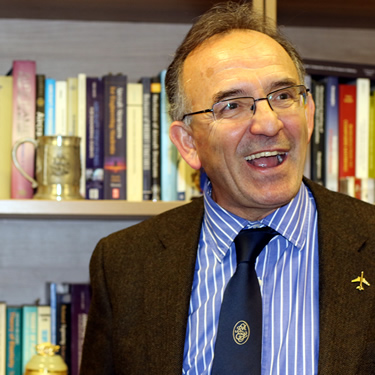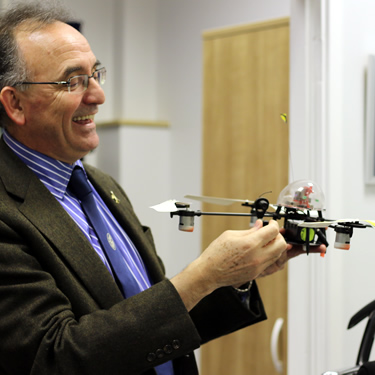#MondayMaterials Episode 14 – Professor Constantinos Soutis
Meet the Department 7 December 2015
Hello all – and welcome to the final #MondayMaterials of 2015! Yes, I know there’s a few Mondays left in the year yet, but after 14 excellent episodes I figured the series deserves a Christmas break.

Don’t worry, though, we’re ending on a high point. Professor Constantinos Soutis (Costas) is a Professor of Aerospace Engineering, the Director of the Aerospace Research Institute, and a Fellow of the Royal Academy of Engineering. Pretty impressive stuff. He is also one of the most interesting and engaging people I’ve met while filming these interviews!
Costas will be back on the blog early in the New Year, telling us about the Aerospace Research Institute. But for now, let’s learn a little bit more about him:
Hi Costas, thanks for chatting to us. Could you start by describing your research, for the layman, in ten sentences or less?
My research work examines advanced materials, non-metallic, for the aerospace sector!
Great, thanks. Possibly the most to the point answer we’ve ever had – I like it! Okay, then. Can you tell us a little bit about how your research benefits the public?
[youtube https://www.youtube.com/watch?v=DeJ-lo7zRNw]My research focuses on understanding and developing new materials systems and, more specifically, carbon-fibre reinforced plastics.
The aim there is to make structures lighter. And by making the structure lighter it means that you might use less material, and the lighter structure might consume less fuel. Which then, overall, is going to be to the benefit of the environment. And we should care about the environment.
Well said! And how did you first get interested in your research area?
[youtube https://www.youtube.com/watch?v=Zqr4ydsodMA]Always my passion was aeroplanes. So all my education is on aeronautics. So my first degree is from The University of London, on aeronautics. Then I specialised on aircraft structures at Imperial College London. And then I did my PhD on fracture mechanics and damage mechanics of modern materials and non-metallic materials composites.
And the rest is history as they say, because I did continue studying and investigating and researching these fascinating materials systems.
If we go back a little bit further, then, can you tell us who or what first inspired your interests in science and engineering?
[youtube https://www.youtube.com/watch?v=MW8cHQBTtAg]Oh, there are so many people that can inspire you and attract your interest and then you dedicate yourself on that subject.
But always I was impressed and fascinated with the work by Leonardo da Vinci. He was an artist, he was a mathematician, he was a scientist, he was an aerospace engineer – he designed the first flying machine!
So I would say that Leonardo da Vinci was a very, very modern man – a very multidisciplinary man.

And what about your interests outside of work? What else do you get up to in your spare time?
Outside of the work I would say my mind never actually switches off. You go home and you still think composites – and I would like to think my students also think composites all the time!
But I used to play squash and tennis, a bit less these days. So during the weekend I might go out to the woods for a bit of a walk, a bit of cycling. And I like driving as well – I enjoy driving in my Alfa Romeo.
Well as you never switch off from work, then – can you tell us a bit about how being here in Manchester has helped your work and research?
I find Manchester, the city, very exciting. But also the University provides the opportunities to work with people from different disciplines.
I mean we’ve mentioned already my research work on composites and carbon fibre reinforced plastics, focusing mainly on aerospace. But we know that these materials, they are used today in Formula 1 – so all the people are aware of carbon fibre. Of course, for people who play tennis, again, they will spend a bit more money to buy a carbon fibre racquet, and ideally if it’s graphene reinforced carbon fibre.

And what Manchester gives you, it gives you that opportunity to interact with the chemist, because in my case I am more a fractures mechanics person, but I need to understand the chemistry because after all the composites contain a polymer – and Manchester gives you that opportunity to interact with a polymer chemist. And to interact also with someone who can manufacture and build things with composites.
And then I can also interact with people from the National Graphene Institute, where graphene can be used as a nano-reinforcement in the polymer that can improve the fracture toughness of the composite. It can produce a system that is stronger, that is stiffer, that is lighter, but at the same time it can introduce a multi-functionality aspect for designing the thermo-conductivity, the electrical properties – and the list goes on and on.
So personally for me, I’m collaborating with people from the Electrical and Electronic Engineering department on sensing damage, mostly internally, in the composites structure. I work closely with people from the Mechanical, Aerospace, and Civil Engineering School. And also people, of course, from our School of Materials. And then I work with those in Atmospheric Sciences, on work related to aircraft emissions and asking ‘what’s the effect of these aircraft emissions on the environment?’
So Manchester provides all those opportunities for collaboration and setting up multidisciplinary projects, which hopefully benefit also the society as a whole.
Thanks so much, Costas – what a fascinating interview. Personally, I can’t wait to catch up with you again in the New Year and learn more about the Aerospace Research Institute. See you then!
And to the rest of you, thanks for reading and have a good Christmas. Don’t forget to visit #MondayMaterials and the UoM Materials Blog when we return!
Advanced MaterialsAeroplanesAerospaceCarbon FibreEnvironmentSchool of MaterialsThe University of Manchester





Leave a Reply